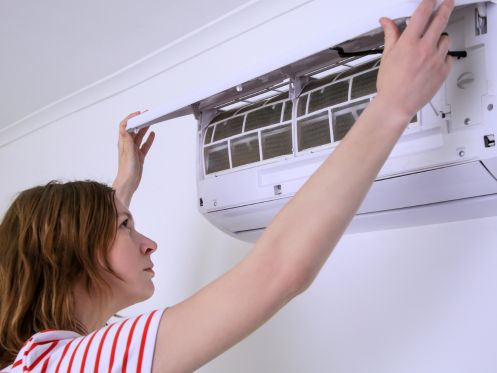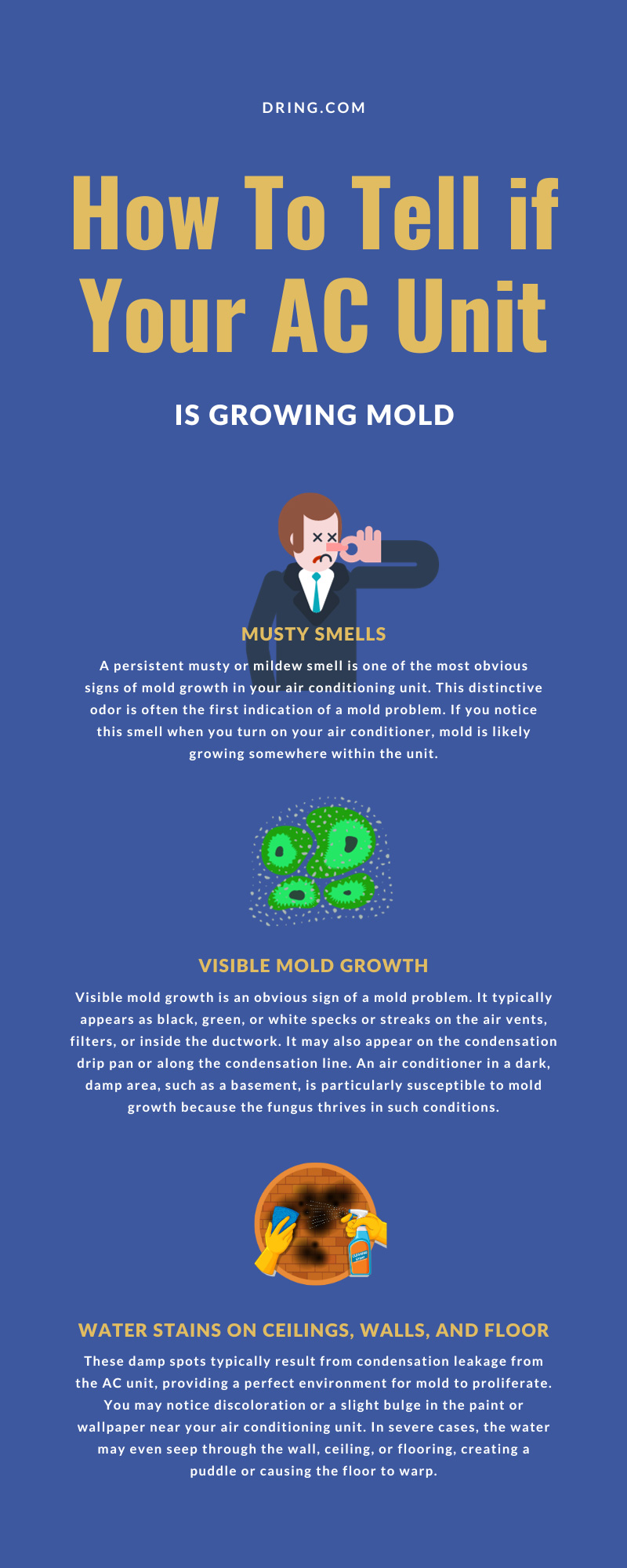Air conditioning units are valuable for fighting off the sweltering heat of summer, blowing cool air around the rooms they are installed in. However, they can also become a breeding ground for an unseen yet harmful intruder—mold. This unwelcome guest compromises the efficiency of your AC unit and poses significant health risks to your household.
Understanding how to identify the presence of mold in your AC unit is crucial for timely intervention and remediation. We’ll share the telltale signs of mold growth so that you can take swift action if necessary. From there, you can keep your home comfortable all year round with climate control.
Signs of Mold Growth in an AC Unit
Mold is an intrusive contaminant, especially when it comes from your air conditioning unit. Check out these common signs of mold, their origins, and how to combat them.
Musty Smells
A persistent musty or mildew smell is one of the most obvious signs of mold growth in your air conditioning unit. This distinctive odor is often the first indication of a mold problem. If you notice this smell when you turn on your air conditioner, mold is likely growing somewhere within the unit. The scent may be particularly strong near the air vents but can move around your home, especially if the mold growth is extensive. Don’t ignore this smell! It signifies a serious issue that requires immediate attention.
Mold can damage your air conditioning unit and have detrimental effects on your health. You may develop respiratory issues after extended exposure to mold spores. Thoroughly clean and dehumidify your AC unit to combat smelly mold growing in your air conditioner. You might have to hire professional HVAC services to eradicate the mold and restore your home to a healthy, odor-free environment.
Visible Mold Growth
Visible mold growth is an obvious sign of a mold problem. It typically appears as black, green, or white specks or streaks on the air vents, filters, or inside the ductwork. It may also appear on the condensation drip pan or along the condensation line. An air conditioner in a dark, damp area, such as a basement, is particularly susceptible to mold growth because the fungus thrives in such conditions.
Remember, mold can become incredibly harmful with prolonged exposure, so we recommend hiring a professional mitigation service to protect your home.
Water Stains on Ceilings, Walls, and Floor
Water stains on ceilings, walls, and floors near your air conditioning unit might signify mold growth. These damp spots typically result from condensation leakage from the AC unit, providing a perfect environment for mold to proliferate. You may notice discoloration or a slight bulge in the paint or wallpaper near your air conditioning unit. In severe cases, the water may even seep through the wall, ceiling, or flooring, creating a puddle or causing the floor to warp. Don’t ignore these problems! Seek assistance from mold mitigation experts as soon as possible to reduce your risks of exposure.
Tips To Keep Your AC Mold-Free
Understanding the signs of mold growth in your air conditioning unit can help with taking preventative measures beforehand. So, here are some tips to keep your air conditioning unit mold-free and improve indoor air quality.
Perform Regular AC Maintenance
Regular maintenance of your air conditioning unit can prevent mold growth. This involves routine cleaning of the AC filters, ducts, and coils to remove accumulated dust and moisture that could foster mold growth. Replace the filters every 90 days, and clean the air ducts and coils annually. Routinely inspecting and cleaning the condensation drip pan and condensation line can prevent the buildup of standing water—a common catalyst for mold development.
Utilizing a dehumidifier for your air conditioning unit can help you maintain optimal humidity levels in your home and deter mold development. While you can perform some of these tasks yourself, hiring a professional HVAC service for an annual check-up can ensure your air conditioning unit is clean and operates efficiently.
Replace AC Filters Regularly
Frequently replacing your air conditioning unit filter can prevent mold growth. Filters can become clogged with dust, debris, and moisture over time, creating an ideal environment for mold to thrive. Replacing the filters every 90 days or three months can improve airflow and minimize the chance of moisture buildup.
This simple yet crucial maintenance step promotes a mold-free and healthy indoor environment. If you feel uncertain about replacing the filter, consider consulting a professional AC service provider.
Inspect the Drain Pan
Inspect your air conditioning unit’s drain pan regularly to prevent mold growth. The drain pan is typically located beneath the cooling coils and collects condensation that drips from the coils. However, if the drain pan becomes blocked or damaged, standing water can accumulate and create an environment for mold to fester.
During your inspection, ensure the drain pan is free from debris and that the drain line is clear and functional. If you notice water pooling in the drain pan, the drain line may be clogged and in need of immediate attention. Fortunately, a professional AC technician can detect and resolve these issues.
Contact an AC Professional
When you notice signs of mold growth in your air conditioning unit, promptly contact a professional heating and cooling unit technician. They have the knowledge and experience to diagnose, treat, and prevent mold infestations in your AC system. They can thoroughly decontaminate your air conditioning unit, ensuring it operates efficiently and blows clean air around the room or area it’s installed in.
Regularly scheduling professional maintenance can also help you eliminate problems before they worsen, significantly reducing the risk of mold growth. Trusting these professionals provides peace of mind in knowing your AC unit is in capable hands and your household is safe from mold-related health risks.
Dring specializes in professional AC unit repairs and installations for homeowners and business owners. Our services for air conditioning repair in Carrollton, TX ensure your AC and heating systems are in great condition throughout the year. Contact us today to schedule an appointment.








